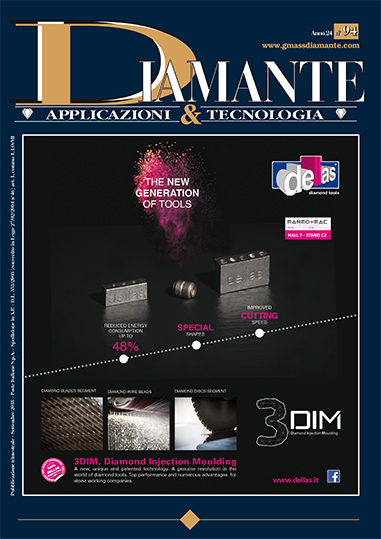|
Diamante A&T Contents Year XIV - September 2018 |
|||||
|
Front Cover: DELLAS S.p.A An example of leading-edge excellence in the stone cutting sector since 1973, in 40 years of activity, Dellas Spa has reached a leading position in the international market of the production and sale of diamond tools for marble, granite and engineered stone. In the Spotlight 12) Euro PM2018 Congress & Exhibition, gets set for Bilbao 17) G.B. F.LLI BERTONCELLO, quality, experience and passion in the manufacturing of industrial furnaces 20) 3DIM, a latest generation technology by Dellas 24) MWS, over 20 years of experience at diamond tools service Diamond Tools 28) Consolidation of a Fe-Cu-Nb binder by SPS by L. T. da S. Soffner1, J. M. B. Rosa1, K. de S. Silva1, B. F. de Oliveira1, C. S. de Carvalho2, M. Filgueira11 LAMAV, State University of the North Fluminense Darcy Ribeiro, Campos dos Goytacazes, RJ, Brasil 2 PROPEMM, Federal Institute of Espírito Santo, ES, Brasil
Abstract: Spark plasma sintering (SPS) technique enables powders consolidation by using heat and pressure simultaneously at shorter times than conventional sintering techniques. In the present work, the elementary powder mixtures of Fe-Cu-Nb was sintered via spark pulsed plasma. The main objective is to investigate the hardness behavior in function of variation of sintering temperature to analyze its possible application as a diamond binder material. All the samples were prepared using as sintering parameters, temperatures of 700°C, 750°C, and 800°C and constant pressure of 35 MPa for approximately 3 minutes. The specimens were characterized by confocal microscopy, scanning electron microscopy (SEM) and energy dispersive spectroscopy (EDS) and X-ray diffraction. Relative density of bulk was determined by Archimedes’ principle and microhardness of constituents and hardness was evaluated in Vickers and Brinell scales, respectively. The microstructure was characterized by a matrix made of Cu with Nb and Fe rich particles indicating the occurrence of liquid phase sintering due to lower melting point of Cu. The microhardness of Nb rich particles raised with sintering temperature increase. Higher sintering temperatures provided the increase in relative density and hardness. Although the diffusion of the elements was not clear by EDS mapping, the formation of an intermetallic compound Fe2Nb at the higher temperature was found. 36) Invar powders obtained by mechano-synthesis for use in diamond tools by F. R. Gomes Amorim, A. A. Araújo dos Santos, G. N. Araújo Coelho, R. da Silva Guimarăes, M. FilgueiraNorthern Fluminense State University - UENF, Campos dos Goytacazes, RJ, Brasil
Abstract: The system FeNi, such as Invar, Elinvar and Permalloy, have many interesting structural properties such as physical and magnetic properties, which make them of great technological importance. There are many processing methods for these alloys, among which we can mention the evaporation of metals and mechano-synthesis. The aim of this work is to evaluate the efficiency to process the alloy Invar (Fe-36%wtNi) by mechano-synthesis for future use as a binder in diamond tools - due to the fact that the thermal expansion coefficient of Invar alloy is near from that of diamond. Different times were used in the high energy ball milling (1 h, 2 h, 2 h 30 min, 5 h, 10 h and 20 h). The relevant characterizations were made by sedigraphy, x-ray diffraction, and scanning electron microscopy. The results showed the effectiveness of the process for a time of 10 h milling, where complete solid solution of the Invar was achieved. Mechanical
44) Metal bond CBN grinding wheel tuned to maximum performance by Lach Diamant 46) WireDress® by Studer - When grinding receives an unprecedented dimension 50) Diamond composites sintered using SPS method by Jolanta Laszkiewicz-Lukasik, Piotr Putyra, Lucyna Jaworska, Slawomir Cygan, Jolanta Cyboron Centre for Materials Research and Sintering Technology, The Institute of Advanced Manufacturing Technology, Cracovia, Poland
Abstract: In this article, investigations of physical and mechanical properties of diamond composites fabricated via Spark Plasma Sintering/Field Assisted Sintering method (SPS/FAST) are presented. This method belongs to low pressure sintering techniques. The aim of the work was to determine the influence of heating with pulsed current and of exothermic reactions on the sintering process of diamond materials. As precursors of the exothermic reaction, tantalum and boron powders were selected to increase the kinetics of the heating rate and to limit phase transitions of metastable super-hard phases. As a metallic bonding phase, fine-grained nickel powder was selected. 56) Fabrication of nano-diamond/silicon carbide composite abrasives dispersed functionally graded materials by centrifugal sintered-casting and its drilling performance for CFRP laminates by T. Kunimine1, 2, K. Kurachi3, H. Tsuge4, M. Yamada2, H. Sato2, Y. Watanabe21 Kanazawa University, Kanazawa, Ishikawa, Japan 2 Nagoya Institute of Technology, Nagoya, Aichi, Japan 3 Gifu Prefectural Ceramics Research Institute, Tajimi, Gifu, Japan 4 Industrial Research Institute of Gifu Prefecture, Oze, Seki, Japan
Abstract: This study aims to investigate drilling performance of nanodiamond/micro silicon carbide (SiC) composite abrasives dispersed functionally graded materials (FGMs). Nano-diamond/micro SiC composite abrasives were made by Nobilta (Hosokawa Micron Corporation) with amorphous silica as a bond material. These composite abrasives were mixed with Cu powder. For comparison, a powder mixture of micro SiC abrasives and Cu powder was also made. Copper-based FGMs including nano-diamond/micro SiC composite abrasives or micro SiC abrasives were fabricated by centrifugal sintered-casting: the combination of centrifugal sintering and centrifugal casting. Carbon fiber-reinforced plastic (CFRP) drilling tests were performed by using these FGMs as drilling tools. CFRP laminates were used as workpiece material. Drilling tests were carried out by using dual-axis grinding wheel system equipped with the fabricated FGMs. Thrust force was evaluated with force sensor. 62) UCIMU meeting - Excellent 2017 for the manufacturing industry of machine tools, robot and automation Stone 68) Life cycle inventory of Brazilian natural stones by Monica Castoldi Borlini Gadioli, Nuria Fernández Castro, Carlos Eduardo Ribeiro WandermuremCentre for Mineral Technology - CETEM/MCTIC, Cachoeiro de Itapemirim, Espírito Santo, Brasil
Abstract: Brazil is one of the main producers and exporters of natural stones in the world. Aiming to contribute to environmental improvements, the life cycle inventory of Brazilian natural stones - LCI Stones was elaborated. This paper intends to present the results obtained along the LCI Stones project. The project was carried out according to the Brazilian methodology for the elaboration of inventories and to the 14040 and 14044 ISO standards. The study consists of two product systems: quarrying and processing (which is divided in two others systems: sawing and polishing), being the last one the main system of study. The product considered is the polished slab. The data were collected within companies, comprising a representative time period for the inventory validation. All inputs and outputs of mass, water and energy as well as products and emissions, within the boundaries, were identified and quantified. The main difficulty found in the data collection was the lack of data control in the companies, mainly the water and energy consumption and polishing inputs. The results of the study showed that, among the stones production processes, gang saw cutting was the one with the most relevant impacts. 74) New uses for rejects of the industrial production of marble and granite by Renato J. A. Paldes
Abstract: The work contains elements that propose a more accurate vision for the use of the so-called tailings of the industrial process of ornamental rocks. In it, the losses inherent to the extraction of blocks were not computed, but focused the industrial process of sawing and cutting the granites in the industries. Although small, the actions of exploitation, try to minimize the large amount of solid residues resulting from the squaring of blocks and the sawing of the slabs and tiles. Creating ways to make a more rational use of almost the entire granite block is to provide industrialists with better conditions to market, improving their use, reducing costs and also reducing solid waste. In addition to allowing specifiers and architects new ways of using ornamental rocks and invite them to reflect on creating new forms of use. News and Events 80) Natural stone: a decline in Made in Italy exports in the first six months of 2018. Exports of marble blocks and slabs to China and India slow down Concrete Cutting 88) The second edition of GIC - Giornate Italiane del Calcestruzzo/Italian Concrete Days in Piacenza 90) Night cutters. Slicing seven miles of concrete in the middle of oncoming traffic |
|||||

